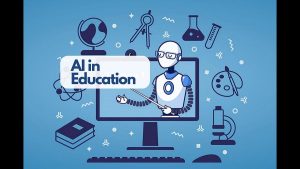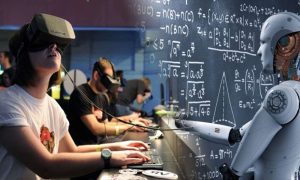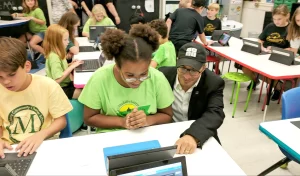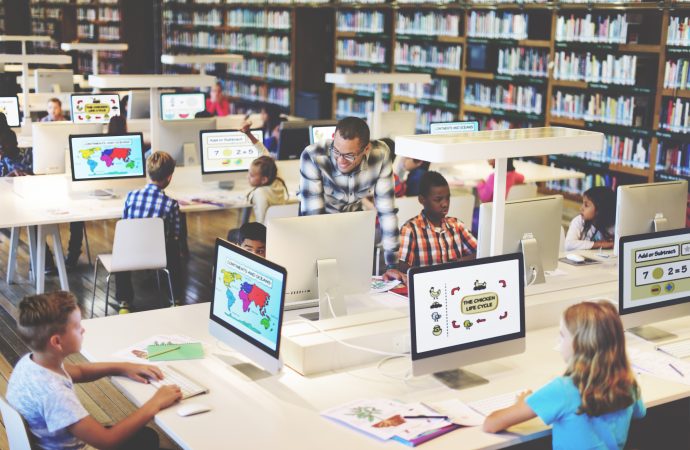How AI is Revolutionizing the Education Sector Artificial Intelligence (AI) is undeniably one of the most transformative forces in today’s world, revolutionizing a wide array of industries, with education being one of the most significantly impacted sectors. The incorporation of AI technologies in educational institutions is reshaping the way students learn, teachers teach, and educational
How AI is Revolutionizing the Education Sector
Artificial Intelligence (AI) is undeniably one of the most transformative forces in today’s world, revolutionizing a wide array of industries, with education being one of the most significantly impacted sectors. The incorporation of AI technologies in educational institutions is reshaping the way students learn, teachers teach, and educational systems operate globally. From personalized learning experiences to teacher support and AI’s ability to reach underserved communities, AI has enormous potential to enhance education. However, it also brings challenges, including ethical concerns and the need for equitable access. This article explores the ways AI is transforming education, offering benefits, examples, and case studies to illustrate its impact.
Introduction to AI in Education
AI in education is not a distant possibility—it is a current reality. Schools, universities, and educational platforms worldwide are increasingly adopting AI tools to optimize learning outcomes and improve administrative functions. From intelligent tutoring systems to AI-powered content creation, AI is permeating various facets of education, streamlining processes, and enhancing efficiency. According to a report by McKinsey, AI in education is projected to bring about significant cost savings while enhancing the quality of education through personalized, data-driven strategies. AI is transforming both the way students engage with learning and how teachers manage their classrooms, making it one of the most pivotal shifts in the modern educational landscape.
Personalized Learning: A Tailored Educational Experience

Image by Yandex.com
One of the most groundbreaking applications of AI in education is personalized learning. Traditionally, education systems have employed a one-size-fits-all approach, where students of the same grade level often receive the same instruction, regardless of their individual learning styles, strengths, and weaknesses. AI changes this paradigm by enabling adaptive learning systems that tailor content to the needs of each student, ensuring that they receive instruction at their own pace and ability level.
AI-powered platforms like Khanmigo, developed by Khan Academy in collaboration with Microsoft, are revolutionizing personalized learning. Khanmigo is an AI tutor that provides real-time feedback to students, answering questions, offering explanations, and guiding them through assignments. It can also assist teachers by analyzing data and recommending instructional strategies based on each student’s progress.
A major benefit of personalized learning is that it supports students who may struggle in traditional classroom settings. For example, a student who needs more time to grasp a math concept can use an AI tool that adjusts the difficulty of problems, provides targeted explanations, and reinforces concepts in a manner tailored to their needs. Similarly, students who grasp material quickly can be given more challenging content, ensuring they are continually challenged and engaged.
AI-Powered Tutoring and Feedback
AI-driven tutoring systems are transforming how students access support outside of traditional classroom hours. These platforms provide on-demand assistance, allowing students to receive help whenever needed. Traditional tutoring systems often require scheduling and availability, but AI tutoring platforms, such as Socratic and Brainly, are available 24/7, providing immediate help to students.
For instance, AI-powered tutoring systems can provide immediate corrections, explanations, and feedback. Instead of waiting for the next day’s class or tutoring session, students can interact with AI systems to correct mistakes in real time, solidifying their understanding instantly. This instant feedback loop is essential for mastering difficult concepts and preventing misconceptions from taking root.
A notable example is Duolingo, an AI-driven language learning platform. Duolingo uses AI to personalize lessons based on a learner’s progress, offering bite-sized, gamified lessons that adapt to the user’s learning speed and performance. It’s a widely-used tool, with millions of users worldwide, proving that AI-powered tutoring can be both effective and accessible.
AI in Teacher Support and Administrative Efficiency

Image by Yandex.com
AI isn’t just changing how students learn; it’s also helping educators manage their workload more efficiently. Teachers spend a significant amount of time on administrative tasks such as grading, lesson planning, and tracking student progress. AI tools can assist in these tasks by automating repetitive tasks and providing insights into student performance.
For example, AI-based systems can grade assignments, quizzes, and even essays, freeing up teachers’ time for more creative and interactive aspects of teaching. This not only reduces administrative burden but also ensures consistency and accuracy in grading. AI tools like Grammarly also assist teachers in providing feedback on writing, helping them focus on the content while the tool handles grammar and language-related issues.
In addition to grading, AI can help with lesson planning. Platforms such as Socrative and Edmodo leverage AI to analyze student performance data and suggest instructional content and activities that can improve learning outcomes. By processing large volumes of data quickly, AI enables teachers to make informed decisions about the best instructional strategies for their classrooms.
Reintegration of AI Tools in Schools
Initially, some educational institutions were wary of AI tools, fearing that they might undermine traditional teaching methods or lead to cheating. However, as the potential of AI has become clearer, many schools are reevaluating their stance. For example, the New York City public school system reversed its ban on ChatGPT, recognizing that the AI tool could enhance learning if used responsibly. This shift highlights how the education system is beginning to embrace AI technologies in the classroom.
AI can help students develop critical thinking and problem-solving skills if integrated thoughtfully. Rather than relying solely on AI for answers, students can use tools like ChatGPT to help them brainstorm ideas, find relevant resources, and improve their writing. Educators, too, can use AI to enrich their teaching methods, ensuring that they are using the latest tools to help their students succeed.
Challenges of AI Integration in Education
Despite its many benefits, the integration of AI in education presents several challenges. The most significant of these challenges is the issue of academic integrity. As AI tools become more advanced, students may be tempted to use them to complete assignments dishonestly. This raises concerns about cheating and plagiarism, especially with generative AI tools that can write essays and solve problems.
In response, educators are exploring ways to incorporate AI responsibly. Some schools are developing new policies to teach students how to use AI ethically, rather than banning it altogether. There is also a growing emphasis on digital literacy—helping students understand how to use AI as a tool for learning, not as a shortcut to avoid engaging with the material.
Another challenge is ensuring equitable access to AI tools. While AI has the potential to bridge educational gaps, it also runs the risk of exacerbating inequalities. Students in low-income areas or developing countries may not have access to the devices or internet connectivity necessary to use AI tools. To ensure equitable access, governments and organizations must invest in infrastructure that provides students with the technology they need to benefit from AI.
AI for Global Educational Equity

Image by Yandex.com
One of the most exciting aspects of AI is its potential to improve access to education in underserved regions. In areas where traditional education resources are scarce, AI can play a pivotal role in bridging gaps. For example, AI-powered platforms are being used to deliver educational content to students in rural parts of Africa and Asia, where teachers and resources are in short supply.
A case study in Malawi illustrates this impact. The AI-powered chatbot Ulangizi, designed by Opportunity International, provides agricultural advice to farmers in Malawi in their native language, Chichewa. This initiative demonstrates AI’s potential to offer customized, accessible knowledge to communities that may otherwise be left behind.
Furthermore, AI’s ability to deliver content in different languages and adapt to various educational needs makes it a powerful tool for providing educational opportunities to children in remote or conflict-affected regions. Organizations like UNICEF are exploring the use of AI to deliver educational content to displaced children and others who lack access to formal schooling.
AI in Enhancing Teacher-Student Interactions
AI can also enhance the teacher-student interaction, providing a more personalized and effective learning experience. While AI tools like Khanmigo and ChatGPT act as tutors for students, they also allow for better interaction between teachers and students. Teachers can monitor student progress more easily and provide timely interventions, while students can engage in more meaningful and customized learning experiences.
For example, teachers can use AI tools to track individual students’ learning progress and identify areas where they are struggling. With this data, they can tailor their teaching strategies and offer targeted support, ensuring that no student is left behind. Moreover, AI can assist in creating more engaging lesson plans that involve interactive and multimedia elements, which can improve student participation and understanding.
Ethical Considerations in AI Use
As with any technology, the use of AI in education raises important ethical questions. One of the primary concerns is the potential for algorithmic bias, where AI systems unintentionally favor certain groups of students over others due to biased training data. This could lead to unfair treatment of students based on their race, gender, or socioeconomic status.
Moreover, the use of AI in education raises questions about data privacy. AI tools often collect vast amounts of data about students, from their academic performance to their interactions with the system. It’s essential that schools and institutions take steps to protect this data and ensure that it is used responsibly.
To address these ethical issues, many educational institutions are working with AI developers to create guidelines for the ethical use of AI. This includes ensuring transparency in how AI systems make decisions, addressing potential biases, and prioritizing data privacy.
Future Trends and Potential of AI in Education

Image by Yandex.com
Looking forward, the potential of AI in education is vast. In the coming years, we can expect to see more advanced AI systems that can interact with students in increasingly sophisticated ways. For instance, AI-powered virtual classrooms could become commonplace, offering students immersive, interactive learning experiences. Additionally, AI could play a greater role in curriculum development, helping educators design personalized learning pathways for every student.
As AI technologies continue to evolve, the future of education will likely be more inclusive, accessible, and efficient. By embracing AI responsibly, educational institutions can create a more equitable learning environment that benefits all students.
Conclusion
AI is revolutionizing the education sector in profound ways, from personalized learning and tutoring to enhancing teacher-student interactions and providing global educational equity. While challenges remain, including ethical concerns and the need for equitable access, the benefits of AI are undeniable. As AI technologies continue to evolve, they will undoubtedly play a key role in shaping the future of education, ensuring that all students have the tools and resources they need to succeed.
















